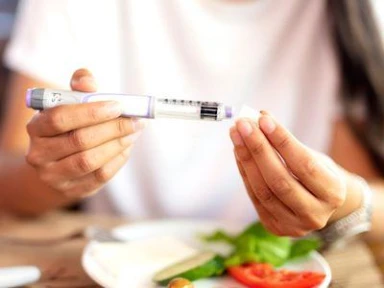Case 1 T2D
Patient Case 1 ─ Type 2 Diabetes (T2D)
Patient Details
-
Demographics: 30-year-old male, with T2D diagnosed 10 years previously
-
Glucose monitoring and glycated hemoglobin (HbA1c) levels:
– Levels were above his personalized HbA1c goal for several years; ranged from 7.8%−10.8% over the previous 1.5 years, despite use of multiple non-insulin therapies combined with basal insulin
– Glucose monitoring was done using fingerstick blood glucose monitoring (BGM) twice a day, with typical values ranging from 160 to 180 mg/dL in the morning, and 140–300 mg/dL before dinner (HbA1c = 8.3%) -
Medical history: Obesity (initial weight = 115 kg [body mass index = 39.5]), obstructive sleep apnea, hyperlipidemia, and microalbumin positivity
-
Glycemic management: Regimen of metformin (1000 mg b.i.d.), canagliflozin (300 mg daily), exenatide extended release (2 mg weekly), and glargine insulin (74 units per day; 0.64 units/kg/day)
-
Initial rtCGM:
– Time in range (TIR, 70–180 mg/dL) = 21.6%
– Time above range (TAR, >180 mg/dL) = 78.4% -
After review and discussion with the patient, basal insulin was increased by 0.1 units/kg/day, to 85 units/day, based on average glucose values being almost entirely >200 mg/dL, and no values being in target glucose ranges.
-
At 2 weeks after this change, rtCGM data:
– TIR = 54%
– TAR = 46% -
Conservative self-titration was encouraged by increasing basal insulin by 1 unit/week if pre-breakfast glucose values were >130 mg/dL without hypoglycemia.
-
Patient’s use of rtCGM data was encouraged to evaluate the impact of food choices and lifestyle on glucose and its use to further optimize management.
-
One month post initiation of rtCGM use:
– Glargine insulin dose increased to 88 units per day
– Non-insulin therapies had been maintained at previous dosing
– TIR = 85.9%; TAR = 14.1%; no time below range
Learnings
-
The initial insulin titration based on the two-week rtCGM data helped significantly to get the patient into the correct ‘ballpark’ glycemic range, by starting stagnant glycemic improvement.
-
Improvement between 2 weeks and 1 month showed that rtCGM data allows individuals to understand and improve critical glucose management issues such as adherence, impact of dietary choices, and impact of lifestyle choices in optimizing glucose levels.

.png/jcr:content/science%20hero%20(1).png)


.jpg/jcr:content/diabetes%20thumb%20new%20(1).jpg)